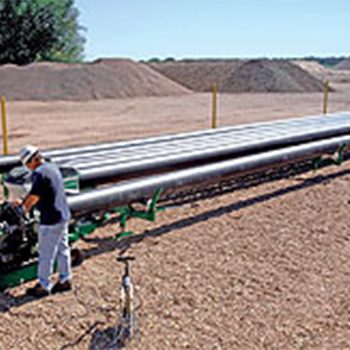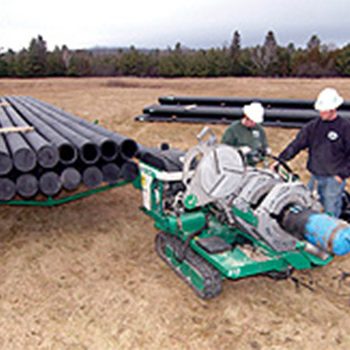Improving efficiency, productivity and safety on the jobsite is always important. After studying jobsites in a variety of markets we determined that a key to improved efficiency, productivity and safety was in job set up and pipe handling. Usually making more pipe joints per day involves more machines and operators which increases costs. With the information gathered from the studies, a new pipe handling system called the PolyHorse® was developed by McElroy. This system stages the pipe strategically on the job site, thus allowing you to increase the number of joints per day and eliminate some labor and loading equipment in the process.
There are various methods for setting up a job. One method is to lay the pipe on the ground where the pipeline will be and move the equipment for each joint. This method involves moving the pipe support stands and the fusion machine to each pipe to be joined which requires additional manpower on the job. This was the chosen method on an Indian reservation where they didn’t want to drag the pipe and disturb the pipeline area any more than necessary. They had a piece of loading equipment and an operator following the fusion equipment from joint to joint to load the pipe. This is the most inefficient method of laying pipe and is mainly used in a constrained space application.
More commonly, pipe is stacked on the ground next to the movable jaw side of the fusion machine. Pipe support stands are then set up on both sides of the fusion machine. Loading equipment is used to individually pick up the pipe from the stack and load it in the fusion machine. After the operator completes the fusion operation another piece of equipment is used to pull the pipe through the machine so that a new stick of pipe can be loaded. This arrangement requires two equipment operators and two pieces of equipment for pulling and loading pipe.
The largest environmental benefit we provided was the HDPE piping system
There are several things about this job set up that could be improved. First, stacking pipe on the ground leads to increased contamination and possible pipe damage. Second is the handling of the pipe into the machine. When using a piece of equipment to swing sticks of pipe from the pipe stack on the ground into the fusion machine all day, there is an increased probability for damage to the fusion machine and possible injury to the fusion operator. If the loading equipment is not available, it is not uncommon to see the fusion machine operator and others on the job try to lift the pipe onto the pipe support stands. This can lead to one of the most common worker compensation claims, back strain.
The PolyHorse® is a new pipe handling system, consisting of a series of adjustable pipe racks positioned on the movable side of the fusion machine. Pipe (4″ to 20″ IPS) is stacked on the racks with loading equipment as it arrives on the delivery truck. This positions the pipe off the ground keeping it clean and protected and eliminating the need to move the pipe multiple times. The pipe is also kept straight so it is easier to clamp and align in the machine during the fusion process.
The fusion machine operator rolls a stick of pipe onto a set of adjustable rollers and easily pulls it into the fusion machine and starts the fusion process. When the fusion joint is complete, pipe can be pulled through the machine and the fusion machine operator can load another piece of pipe. The same piece of equipment can be used for both loading the pipe on the racks and for pulling the pipe out of the machine. This system eliminates one piece of equipment and one operator from the conventional set-up. This new system was used near Sugarloaf, Maine for the Poland Spring Natural Spring Water Company. The job was located on a meadow of grass less than forty feet above a natural aquifer. Surrounded by mostly untouched wilderness, the valley has been a drinking source for people for over 10,000 years. Poland Spring built a pipeline through this meadow which pumps water from the aquifer to one of its nearby bottling factories. The whole project was designed with the natural environment’s protection as the leading vision for the project. Additional measures were taken to ensure the construction site and its environment, remain super clean. “The largest environmental benefit we provided was the HDPE piping system,” said Bill Hanes of VARI-TECH who provided the pipe, and the pipe handling system. Hanes is speaking of the PolyHorse® which eliminated a large piece of construction equipment and sped up the whole operation.”
Because of the efficiency of this new piece of equipment, the fusion machine operator is never waiting for pipe to be loaded, which ultimately results in more joints per day. The chart below shows the estimated productivity of the handling system.
Handling System Productivity Analysis
| Pipe Size | Existing Method | Pipe Handling System |
|---|---|---|
| 4-8″ IPS | 24-48 | 40-70 |
| 10-18″IPS | 12-24 | 20-34 |
| 20-24″IPS | 10-16 | 18-20 |
*Estimated Joints per 10 Hour Day
On a job in which (100) butt fusion joints of 12″ pipe are required, the following table shows the cost and productivity savings that can be found.
| Handling Systems | Existing | Improved |
|---|---|---|
| 100 Joints | 5 days (20 J/D) | 3.45 days (29 J/D) |
| Fusion Equipment Rental ($275/day) | $1,375 | $1,100 |
| Fusion Operator ($480/day) | $2,400 | $1,920 |
| Loading/Pulling Equipment ($325/day) | (2)$3,250 (5 days) | (1) $1,300 (4 days) |
| Loading Equipment Operator ($480/day) | (2)$4,800 (5 days) | (1) $1,920 (4 days) |
| Rack System Rental ($100/day) | $400 (4 days) | |
| Total Cost | $11,825 | $6,640 |
| SAVINGS – COST | $5,185 | |
| SAVINGS – TIME | 1.5 days |
Using the improved system resulted in completing the job 1.5 days sooner with an increase in productivity and a decrease in job costs. With the productivity gains of this pipe handling system using 3″ or 4″ pipe, the production can rival using coiled pipe.
Job site set-up and pipe handling are the keys to improved productivity and safety on the jobsite. Using a pipe handling system will help make fusing polyethylene pipe more successful for everyone from the owner to the operator.



